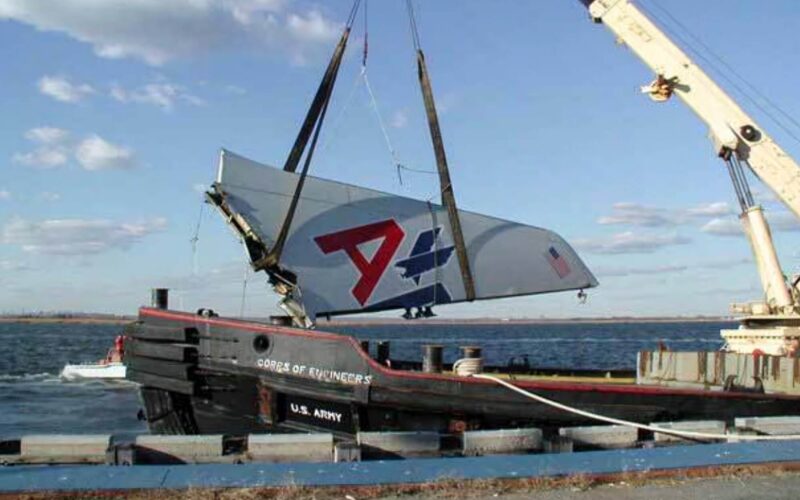Twenty-one years ago, American Airlines (A1G) (AAL) flight 587, a routine passenger flight from New York to the Dominican Republic, crashed into a residential area in Queens just minutes after take-off. A total of 265 people lost their lives in what is one of the worst commercial aviation disasters in the history of the United States.
Coming just two months after 9/11, New Yorkers and people across the globe feared that the loss of the Airbus A300 may have been another terrorist attack. However, the flight on November 12, 2001, would turn out to be a tragic accident, primarily attributed to pilot error.
Wake turbulence
It was during departure that the tragedy unfolded. After leaving John F. Kennedy Airport (JFK), American 587 flew into wake turbulence from a Japan Airlines (JAL) Boeing 747 which had taken off just 1 minute 40 seconds prior.
With turbulence shaking the aircraft, the first officer attempted to stabilize the plane by moving the rudder left to right excessively. However, without realizing it, he was pushing the rudder and tail fin beyond its maximum stress limit.
Within 30 seconds, the excessive rudder movement ripped the vertical stabilizer away from the plane. Without this control surface, which is crucial to stable flight, the Airbus A300 was in trouble. It entered into an uncontrollable dive, hitting the ground at 09:16:14. The flight had lasted just over two minutes.
In total, 260 people on board were killed, plus a further five on the ground.
The investigation
A major clue for investigators was when they realized that American 587 was not intact when it fell out of the sky.
This conclusion was drawn when the aircraft’s tail fin was found in Jamaica Bay, about one mile (1.6 km) away from the main crash site, showing it had detached before impact with the ground. Analysis of the tail’s damage along with the Black Box recordings gave an accurate understanding of what brought down American 587.
Flight path of AA587. Credit: NTSB
During the investigation, the National Transportation Safety Board (NTSB) uncovered pertinent information about how the first officer had dealt with similar situations previously, as well as flaws in the way American Airlines (A1G) (AAL) trained its pilots on dealing with wake turbulence.
NTSB investigators interviewed several American Airlines (A1G) (AAL) pilots who had flown with the first officer. Even though the comments were generally positive, two pilots provided noteworthy accounts concerning the first officer’s reaction to previous wake turbulence encounters.
According to the interviews mentioned in the official accident report, there were concerns with the way he behaved with the rudder controls. An American Airlines (A1G) (AAL) captain who flew several times with the first officer (when they were a junior captain and junior first officer, respectively) told Safety Board investigators that during one flight in 1997, the first officer had been “very aggressive” on the rudder pedals after a wake turbulence encounter. The captain had pointed out these “quite aggressive” rudder pedal inputs to him.
The captain also commented that the turbulence encounter was momentary and required only a small aileron input to roll the wings level, rather than any big rudder movement.
Investigators concluded that: “The first officer had a tendency to overreact to wake turbulence by taking unnecessary actions, including making excessive control inputs.”
A different outcome
Furthermore, investigators believed that the first officer’s concerns about the effect of wake turbulence were likely exacerbated by the Advanced Aircraft Maneuvering Program (AAMP) training provided by American Airlines (A1G) (AAL). One of the simulator exercises portrayed a wake turbulence encounter as capable of quickly upsetting an A300 to extreme bank angles, which was in reality unlikely, and emphasized using rudder to control the aircraft. The captain interviewed by investigators stated that the first officer said he had been trained to use the rudder pedals in such a manner as part of the AAMP.
However, the program had come under criticism from manufacturers, including Airbus, for some of its flying techniques and the emphasis on using the rudder.
If the first officer had held off moving the rudders, the incident could have had a different outcome.
Investigators commented in the report: “In fact, if the first officer had stopped making these inputs at any time before the vertical stabilizer separation, the natural stability of the airplane would have returned the sideslip angle to near 0º, and the accident would have been avoided.”
In the aftermath of the crash, American Airlines’ (A1G) (AAL) pilot training was updated and the lessons of this tragedy passed on to the industry. An accident in such circumstances has not happened again.
Article written by Aleksandras Griskevicius and Victoria Bryan

